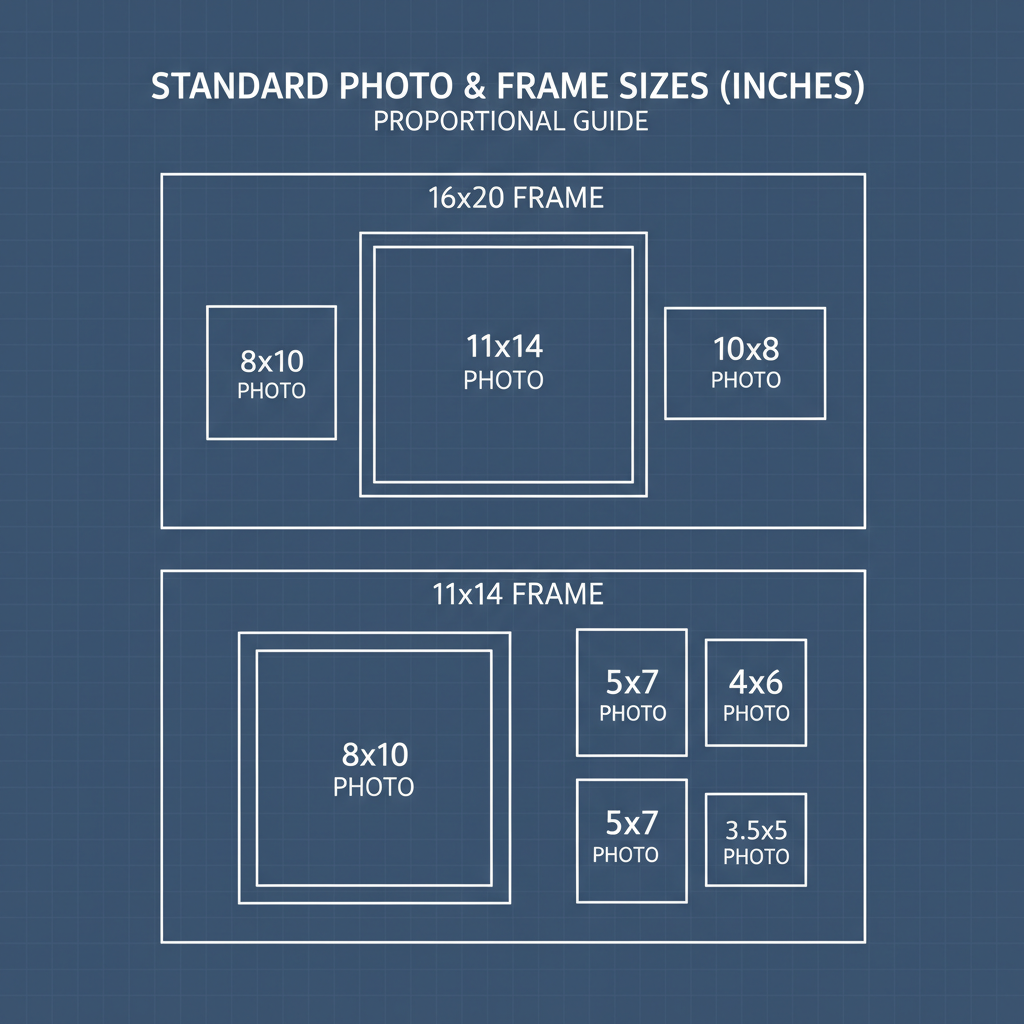Standard Photo Sizes in Inches for Printing and Framing
Learn common photo sizes in inches, aspect ratios, and best uses for printing and framing to ensure perfect fit, clarity, and stunning presentation.

Introduction to Standard Photo Sizes in Inches
For photographers, artists, and anyone passionate about preserving memories, understanding standard photo sizes in inches is key to achieving professional-looking prints. Choosing the right dimensions affects image clarity, framing options, and how your subject is presented. Whether you’re preparing a family portrait, designing a photo wall, or ordering a batch of prints online, knowing the common sizes — and how they match your camera’s aspect ratio — will help you avoid unwanted cropping and maximize visual impact.

Standard photo dimensions are expressed as width × height in inches, and each corresponds to an aspect ratio — the proportional relationship between width and height. If your photo’s ratio doesn’t match your chosen print size, you’ll need to crop the image or accept borders. This guide explains all the popular sizes, resolution requirements, and use cases, so you can print with confidence.
---
Common Standard Photo Print Sizes and Aspect Ratios
Most photo labs and frame makers work within a set of widely available sizes. These make printing cost-effective and framing straightforward.
| Size (inches) | Aspect Ratio | Common Use |
|---|---|---|
| 2×2 | 1:1 | ID photos, passport pictures |
| 3×5 | 3:5 | Small keepsake prints |
| 4×6 | 2:3 | Standard photo albums |
| 5×7 | 5:7 | Framed desk photos |
| 8×10 | 4:5 | Portrait prints |
| 11×14 | 11:14 | Wall display prints |
| 16×20 | 4:5 | Gallery wall art |
| 20×24 | 5:6 | Large decorative prints |
---
Small Print Sizes
Small prints are portable, affordable, and ideal for albums or personal sharing.
2×2 Inches
- Uses: Passport and visa photos, ID cards.
- Notes: Typically governed by official regulations for composition and background.
3×5 Inches
- Uses: Scrapbooking, vintage or retro-styled prints.
- Notes: Less common but still available from some labs.
4×6 Inches
- Uses: Photo albums, everyday prints from smartphones or DSLRs.
- Notes: Matches the 2:3 aspect ratio common in consumer cameras.

---
Medium Print Sizes
Medium-sized prints offer more presence without requiring large display space.
5×7 Inches
- Uses: Desk frames, gifts, small gallery groupings.
- Notes: Slightly bigger than 4×6 for more visual impact.
8×10 Inches
- Uses: Formal portraits, fine art prints.
- Notes: Often requires cropping from a 2:3 image.
8.5×11 Inches
- Uses: Portfolios, document-style prints.
- Notes: Fits standard letter-sized paper for easy home printing.
---
Large Print Sizes
Larger prints are eye-catching and make excellent statement pieces.
11×14 Inches
- Uses: Prominent wall displays, gallery pieces.
- Notes: Maintains clarity while making a bold statement.
16×20 Inches
- Uses: Corporate or home art displays.
- Notes: Scales easily from smaller 4:5 aspect ratio prints.
20×24 Inches
- Uses: Large decorative centerpieces.
- Notes: Demands high-resolution source files.
---
Panoramic and Specialty Photo Sizes
Panoramic options highlight sweeping landscapes or large group photos.
- 4×12 inches: Narrow, striking panoramas for compact spaces.
- 8×24 inches: Wide-format for expansive scenes.
- 12×36 inches: Extra-large for immersive wall art.
Custom frames and print services are usually required for these formats.
---
Digital Aspect Ratio vs Print Size
Understanding your camera’s native aspect ratio helps anticipate cropping needs.
- DSLRs & most smartphones: 3:2 ratio — fits 4×6 perfectly.
- Micro Four Thirds: 4:3 ratio — closer to 8×10 sizes.
- Square format cameras/apps: 1:1 ratio — ideal for 2×2, 8×8.
---
Choosing the Right Photo Size
Factor in the following when selecting your print size:
- Album design: Common layouts accommodate 4×6 or 5×7.
- Framing: Standard sizes avoid custom frame expense.
- Viewing distance: Bigger prints are better from afar.
- Subject matter: Vertical or horizontal orientations suit different subjects.

---
Resolution Requirements for Sharp Prints
Aim for 300 DPI for premium quality. Use this chart for guidance:
| Print Size (inches) | Resolution @ 300 DPI | Minimum Pixels |
|---|---|---|
| 4×6 | 300 DPI | 1200×1800 |
| 5×7 | 300 DPI | 1500×2100 |
| 8×10 | 300 DPI | 2400×3000 |
| 16×20 | 300 DPI | 4800×6000 |
| 20×24 | 300 DPI | 6000×7200 |
---
Cropping Tips
- Enable grid lines: Helps compose shots with printing in mind.
- Allow extra breathing room: Keeps key subjects away from crop danger zones.
- Check lab previews: Most offer a cropping tool before checkout.
---
Printing Materials and Perceived Size
Material finish influences the perceived size and feel of your image:
- Matte: Minimal glare, subtle presentation.
- Glossy: Vivid colors, but can reflect light.
- Canvas: Adds texture, depth, and a fine art appeal.
---
Standard Online Print Service Sizes
Most online print providers offer similar core options:
- Shutterfly: 4×4, 4×6, 5×7, 8×10, 11×14, 16×20, 20×30.
- Snapfish: 3.5×5, 4×6, 5×7, 8×10, 8×12, 12×18.
- Walmart Photo: Broad range, including canvas up to 30×40.
Always review cropping previews to ensure framing matches your vision.
---
Summary
Mastering standard photo sizes in inches ensures your prints look exactly as intended. By pairing your camera’s aspect ratio with optimal resolution and choosing a print material that complements your display environment, you can avoid common pitfalls like distortion or unwanted borders. Keep a quick reference chart handy, and use this knowledge to produce photographs that look their best in albums, frames, or on your walls.
Ready to print your images perfectly every time? Start by matching your favorite shots to the right standard size, and experience professional results with every order.




